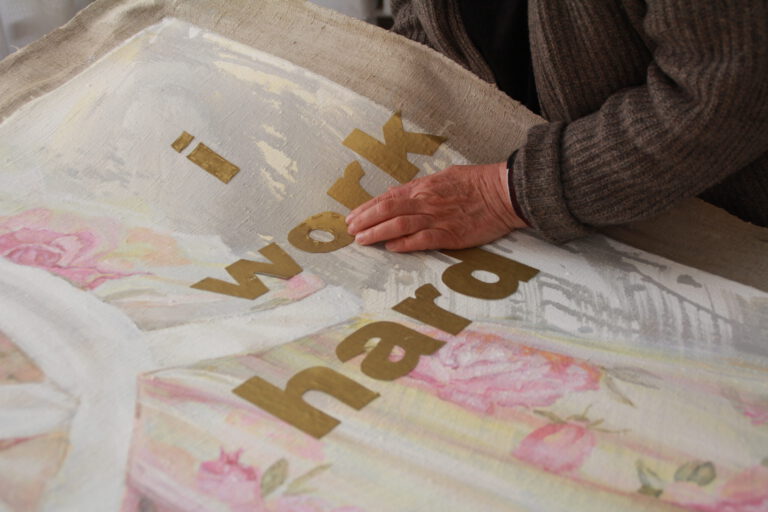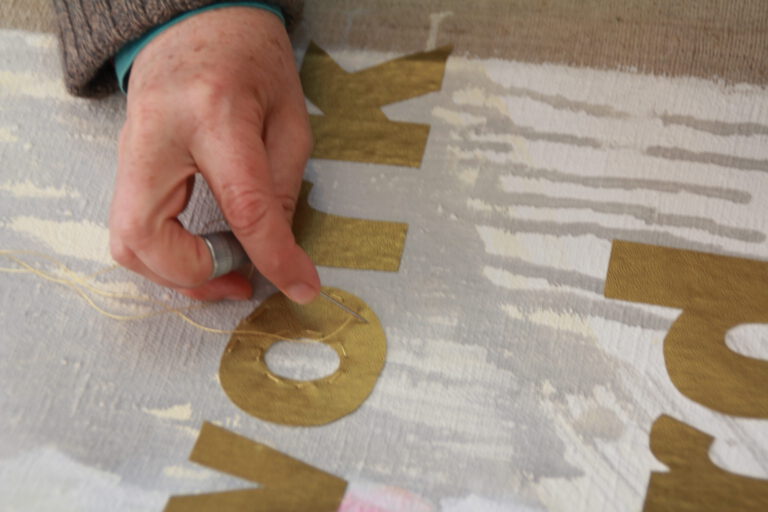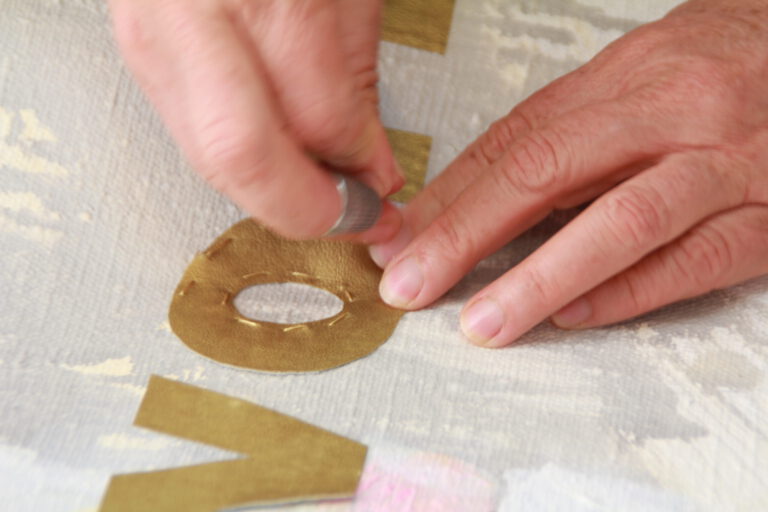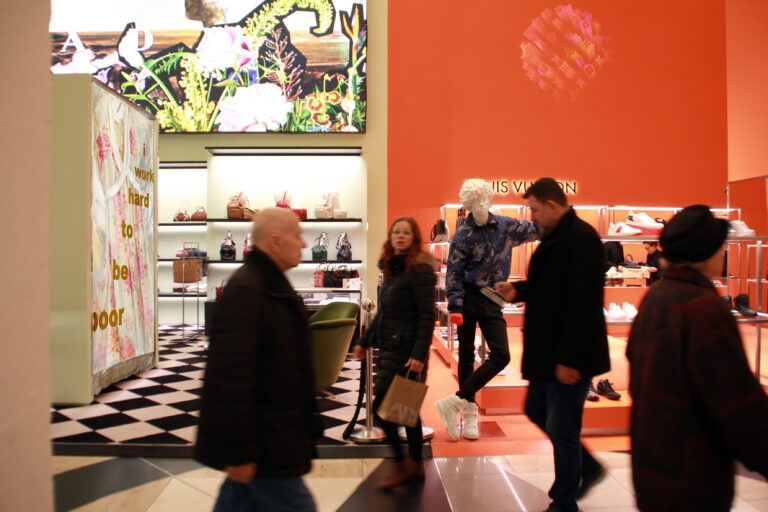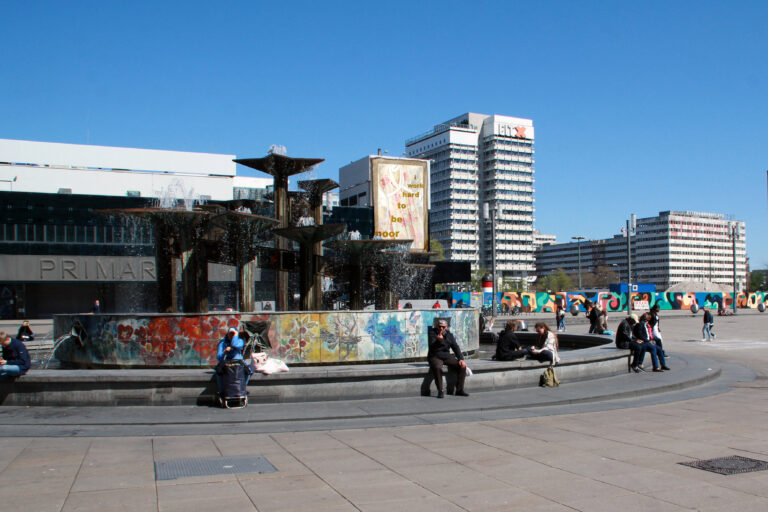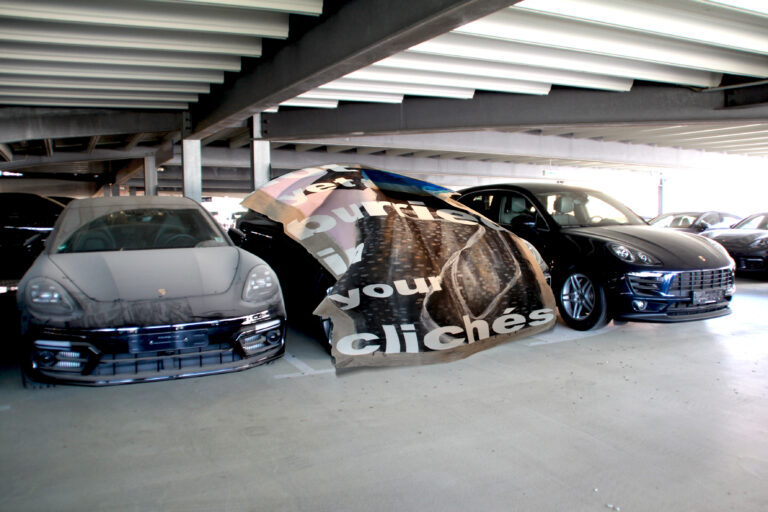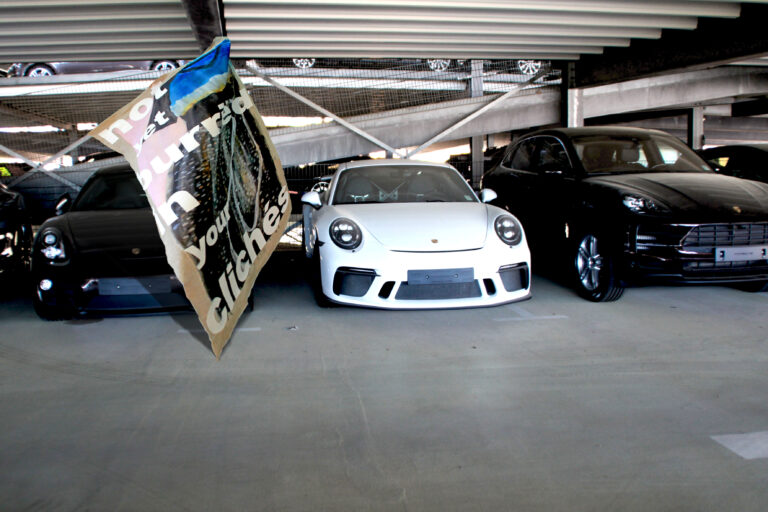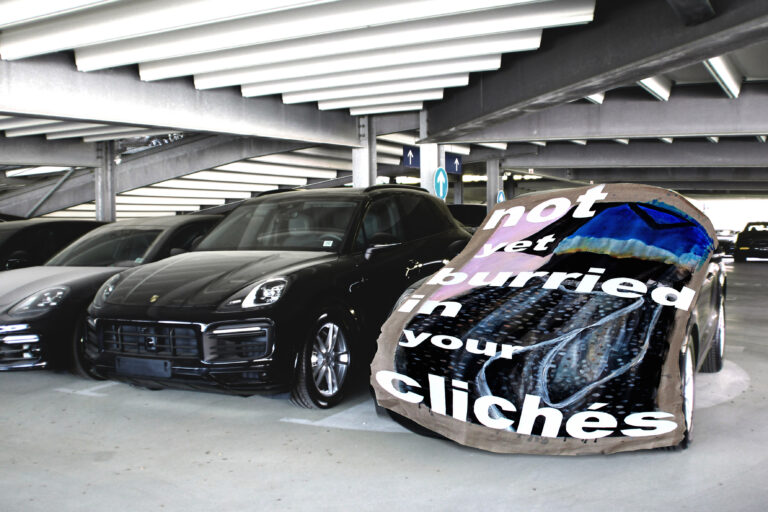See Me Working
Arbeiten Sie gerne? Arbeiten Sie hart? Sind Sie stolz auf ihre Arbeit? Verdienen Sie genug mit ihrer Arbeit? Wird ihre Arbeitsleistung anerkannt? Wertschätzen Sie die Arbeit anderer Menschen?
SEE ME WORKING ist ein interdisziplinäres Projekt, in dem ich mich seit 2015 mit dem Begriff der Arbeit auf mehreren Ebenen auseinandersetze. Die eigene Arbeitssituation formt ganz unmittelbar die Wunschvorstellungen vom eigenen Leben. Das stellte ich im Freundeskreis fest. Bei der Frage, wie unterschiedliche Frauen ihre eigene Arbeit und die damit verbundenen Möglichkeiten einschätzten, zeigte sich, dass die meisten sich als isoliert wahrnahmen. Es fielen immer wieder Begriffe wie Anerkennung, Anpassung, Abhängigkeit, Ignoranz, Wut, Ohnmacht und nicht zuletzt Freiheit. Keine der Befragten sah sich als eine von vielen! Welchen Einfluss hat also unsere persönliche Arbeitssituation als Frau auf unsere gesellschaftlichen Möglichkeitsräume? Das beschäftigt mich sehr und ich versuche zum ersten Mal mich selbst in den Mittelpunkt eines Projektes zu stellen, was mir sehr schwer fällt. Meine persönliche Situation als Künstlerin empfinde ich als Privileg. Doch von meiner Arbeit finanziell zu leben ist phasenweise sehr schwierig. Die finanzielle Unsicherheit setzt mir oft zu, verunsichert mich und führt zu Wut- und Ohnmachtsgefühlen, aber auch zu Überlebensstrategien und Glücksgefühlen. Das thematisiere ich in SEE ME WORKING. Das Projekt besteht aus 3. Teilen:
1. Das Sichtbarmachen eigener Arbeitsprozesse im öffentlichen Raum durch Performance
2. Das Umsetzen in ein bildnerisches Werk
3. Kommunikation mit und Dokumentation von anderen Frauen in ihrer Arbeitssituation.
Do you like working? Do you work hard? Are you proud of your work? Are you earning enough from your job? Is their work recognised? Do you value other people’s work?
SEE ME WORKING is an interdisciplinary project in which I have been dealing with the concept of work on several levels since 2015. Your own work situation directly shapes your wishful thinking about your own life. I noticed that in my circle of friends. When asked how different women assessed their own work and the opportunities it offered, it was found that most perceived themselves as isolated. Terms such as recognition, conformity, dependency, ignorance, anger, powerlessness and, last but not least, freedom, were used again and again. None of the respondents saw themselves as one of many! So what influence does our personal work situation as a woman have on our social possibilities? That occupies me a lot and for the first time I’m trying to put myself at the center of a project, which is surprisingly very difficult for me. I see my personal situation as an artist as a privilege. But living financially from my work is very difficult at times. The financial insecurity often affects me, unsettles me and leads to feelings of anger and powerlessness, but also to survival strategies and feelings of happiness. That’s what I address in SEE ME WORKING. The project consists of 3 areas:
1. Making your own work processes visible in public space through performance
2. The conversion into a graphic work
3. Communicating with and documenting other women in their work situation
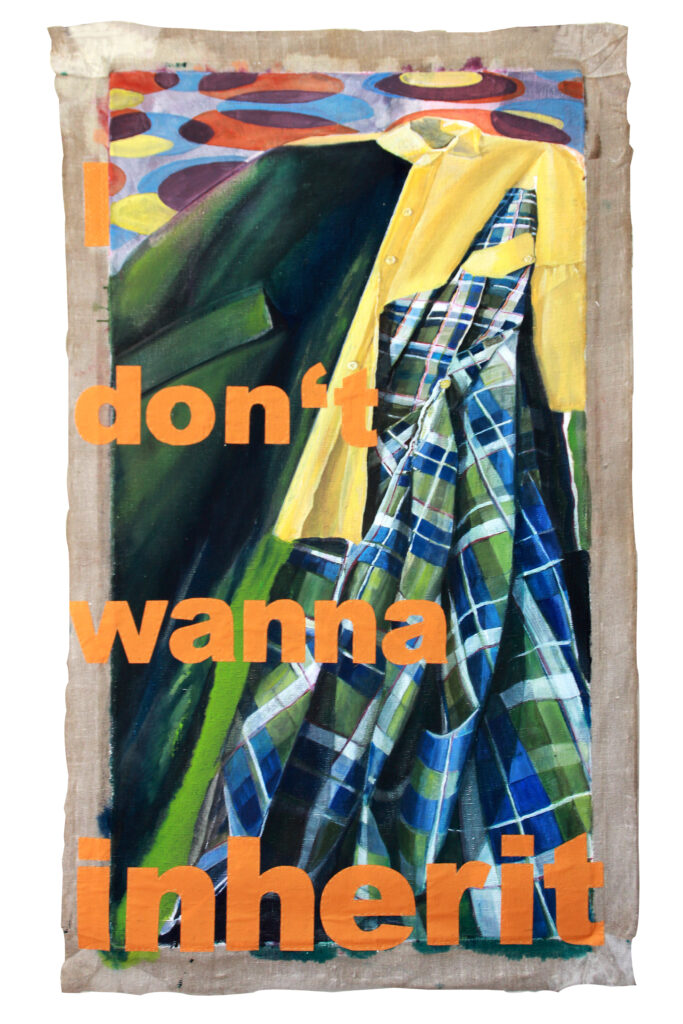
163 x 95 cm
The canvas has been removed from the frame.
Series: see me working
Ich male meine eigenen Kleider als Stillleben in einer Technik aus Acryl und Öl auf Leinwand. Wenn die Bilder getrocknet sind, nehme ich sie vom Holzrahmen ab. Sätze, die ich beim Arbeiten gedacht habe, werden von mir aus Stoff ausgeschnitten, auf die Leinwand appliziert und mit der Hand festgenäht. Aus der Nähe sind die Stiche, die die Buchstaben auf der Leinwand festhalten, gut sichtbar. Das Stillleben und seine Botschaft verweisen auf Arbeit und Handwerk und haben gleichzeitig etwas Plakatives. Ich sehe das als einen ironischen Bezug zu den riesigen Plakaten der Werbewelt, die uns dazu auffordern mehr und mehr zu konsumieren und dabei verbergen, dass das nur durch die schlecht bezahlte Arbeit von Millionen von Menschen möglich ist. Ein 1 Euro Shirt bei Primark fällt nicht aus der Fabrik, sondern wird von einem Menschen erarbeitet. Da diese Kampagnen uns permanent eine Scheinwelt vorspiegeln, habe ich aus jedem Stillleben eine Serie von modernen Trompe-l’oeils entwickelt. Es sind Fotoarbeiten, die ebenfalls eine Scheinwelt zeigen. Meine Ölbilder finden sich inmitten von Müllanhäufungen oder in den Schaufenstern von Modeketten oder in einem Parkhaus wieder. Was ist Wirklichkeit?
I paint the clothes I sewed as a still life using an acrylic and oil on canvas technique. When the pictures have dried, I take them off the wooden frame. Sentences that I thought while working are cut out of fabric, applied to the canvas and sewed again by hand. Up close, the stitches holding the letters on the canvas are clearly visible. The still life and its message refer to work and craftsmanship and at the same time have something striking…I see this as an ironic reference to the giant billboards of the advertising world, urging us to consume more and more while hiding that this is only possible through the poorly paid labor of millions of people. Since these campaigns constantly present us with an illusory world, I developed a series of modern trompe-l‘oeils from each still life. They are photo- graphic works that also show an illusory world. My oil paintings can be found in the midst of piles of rubbish or in the shop windows of fashion chains or in a parking garage. What means reality?
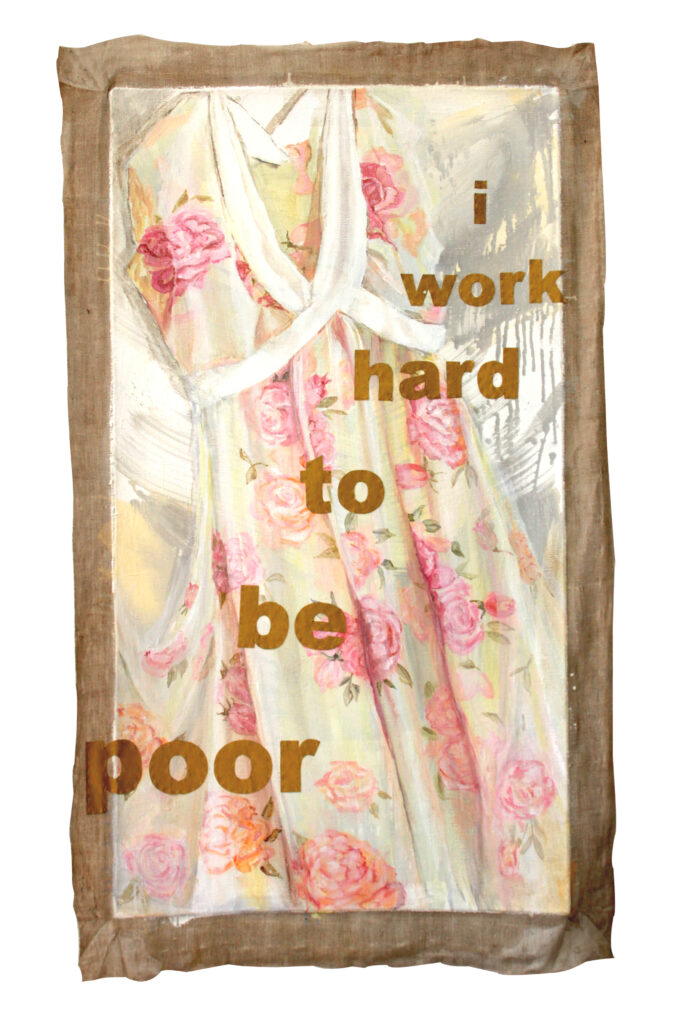
163 x 95 cm
The canvas has been removed from the frame.
Series: see me working
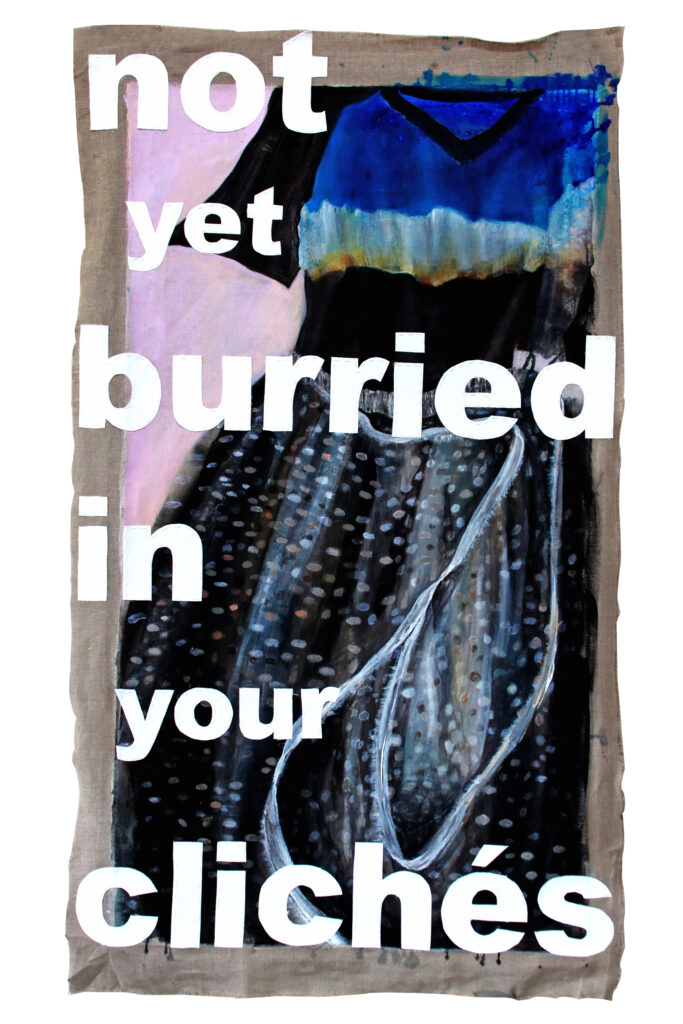
163 x 95 cm
The canvas has been removed from the frame.
Series: see me working
Es dauerte von 2007 bis 2015 bis ich begriff, was meine Projekte eint. Damals steckte ich gerade mitten in meinem Projekt 1+ all, einer Initiative um geflüchtete Frauen in ein Netzwerk aus Handwerkerinnen einzubinden. Zusammen präsentierten wir 1+ all im Projektraum Between Bridges von Wolfgang Tillmans und in der Galerie Springer in Berlin. Das Schicksal der Frauen, ihre Kraft, ihr Mut und ihre Freude an unserem Handwerksprojekt, der Stolz ihre eigenen Traditionen zeigen zu können und die Schwierigkeiten sich in Berlin ein vollkommen neues Leben aufzubauen, haben mich tief bewegt und mich emotional sehr gefordert. Meine eigene Situation war zu diesem Zeitpunkt finanziell sehr angespannt. Ich finanzierte das Projekt selbst aus dem Verkauf unserer kleinen Kollektion, der nie reichte und ich war ständig auf der Suche nach Sponsoren. Ich fühlte mich wie eine Bittstellerin, eine Bettlerin. Vor dem Einkaufsladen in meiner Nachbarschaft stand damals eine ältere Frau aus Rumänien und bettelte auch. Wir unterhielten uns immer ein wenig und sie bestand darauf ihr Betteln wieder und wieder als ihre Arbeit darzustellen. „Muss arbeiten, muss, muss!“ Das hat mir zu denken gegeben, mir oft Mut gemacht und meinen Durchhaltewillen gestärkt, denn auch ich war in einer Muss-Muss-Schleife gefangen. Ich begann ganz anders über Arbeit, Würde und Verantwortung nachzudenken. Und ich machte 2015 im Schaufenster der C+K Galerie in Berlin Mitte meine erste Performance. Für alle sichtbar saß ich dort 5 Tage an der Nähmaschine und nähte vor aller Augen, vor allem vor den Augen von David Chipperfield Architects, deren Büro mir gegenüber lag, ein T-Shirt nach dem anderen aus gebrauchten und ausrangierten T-Shirts. SEE ME WORKING fand dann 2017 in der Galerie Mana in Wien, 2018 in einer ehemaligen Bankfiliale in Linz und im Februar 2020 im Rahmen von „A Femmes City“ im U-Bahnhof Kleistpark in Berlin statt.
It took me from 2007 to 2015 to realize what all my projects have in common. At that time I was in the middle of my project 1+ all, an initiative to integrate refugee women into a network of craftswomen. Together we presented 1+ all in the project space Between Bridges by Wolfgang Tillmans and in the Springer Gallery in Berlin. The fate of the women, their strength, their courage and their joy in our handicraft project, the pride of being able to show their own traditions and the difficulties in building a completely new life in Berlin moved me deeply and challenged me emotionally. My own financial situation was very tense at the time. I financed the project myself from the sale of our small collection, which was never enough, and I was constantly looking for sponsors. I felt like a supplicant, a beggar. At that time, an elderly woman from Romania was standing in front of the shop in my neighborhood and was also begging. We always chatted a little and she insisted on presenting her begging as her work over and over again. “Has to work, has to, has to!” That made me think, often gave me courage and strengthened my will to persevere, because I too was caught in a must-must loop. I started thinking about work, dignity and responsibility in a very different way. And I did my first performance in 2015 in the shop window of the C+K gallery in Berlin Mitte. For everyone to see, I sat there at the sewing machine for 5 days and sewed one T-shirt after the other from used and discarded T-shirts in front of everyone, especially in front of the eyes of David Chipperfield Architects, whose office was across from me. SEE ME WORKING then took place in 2017 in the Mana Gallery in Vienna, in 2018 in a former bank branch in Linz and in February 2020 as part of “A Femmes City” in the U-Bahn station Kleistpark in Berlin.
